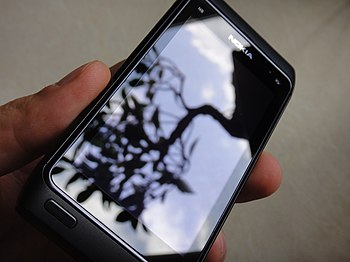大猩猩玻璃

大猩猩玻璃(Gorilla Glass)是美国康宁公司(Corning)下属的一个注册商标,专门生产专业的铝硅钢化玻璃。其生产的玻璃具有高强度、轻薄等特点,因此被大量运用于手机等便携式电子产品,以及电视、电脑等显示器上。[1]这种玻璃运用离子交换技术,在表面形成一层保护膜,使得其有非常优异的防刮特性。[2]
历史
[编辑]康宁公司于20世纪60年代开展的一个名为“Project Muscle”的研发化学钢化玻璃的方案,2005 年,该方案的研发重新开始,研究该玻璃是否可以做得足够薄以用于消费电子产品,2007年乔布斯在舞台上举起塑胶 iPhone 的第二天,就抱怨手机放在口袋后显示器上出现了刮痕。苹果随后联系康宁,要求在新手机中使用薄的钢化玻璃,后续第一代iPhone上配备防刮玻璃最终被称为大猩猩玻璃。
发展
[编辑]| 版本 | 公布 |
|---|---|
| 1 | 2008年2月[3] |
| 2 | 2012年1月[4] |
| 3 | 2013年1月[5] |
| 4 | 2014年11月 |
| 5 | 2016年7月 |
| SR+ | 2016年8月[6] |
| 6 | 2018年7月[7] |
| DX/DX+ | 2018年7月[8] |
| Victus | 2020年7月[9] |
| Victus 2 | 2022年11月[10] |
| Armor | 2024年1月[11] |
| 7i | 2024年6月[12] |
康宁公司曾宣称大猩猩玻璃具有相当好的耐磨特性,而且非常坚硬,其维氏硬度达到了622至701,[13]并且其材料可以回收利用。[14]
第一代
[编辑]第一代的大猩猩玻璃最初是在2007年6月发布的第一代iPhone上使用的,后续于2008年2月正式推出。 2010年,全世界大约有百分之二十,也就是约两亿台手持电子设备使用了大猩猩玻璃。[15]
第二代
[编辑]2012年,康宁公司向公众发布第二代大猩猩玻璃问世。在硬度上有着更高的提升。
2012年10月24日,康宁宣称全世界有超过10亿台电子设备正在使用其生产的大猩猩玻璃[16]第二代大猩猩玻璃比第一代大猩猩玻璃薄20%。[17]。
第三代
[编辑]2013年,康宁公司在CES展会上推出了第三代大猩猩玻璃。根据康宁公司的观点,边缘防护的强化不仅增加不易碰破的特性,第三代大猩猩玻璃的耐划性更是前代产品的三倍。
第四代
[编辑]2014年,康宁发布了第四代大猩猩玻璃。据其官方数据显示,相比普通玻璃屏,第四代大猩猩玻璃从一米高处跌落能够保证80%的完好率,
而普通玻璃的屏幕破裂率几乎为100%。另据了解,第四代大猩猩屏幕在耐磨性上要比上一代提升两倍左右。此时市场占有率已经达到7成。
第五代
[编辑]2016年,康宁先行发布了第五代大猩猩玻璃。宣称跌落高度设定在一米六。有较前代更好的防摔能力,经网络测试防刮能力跟前代相约。
第六代
[编辑]2018年,康宁在美国硅谷发布第六代康宁大猩猩玻璃。在康宁45度角1高度的跌落测试中,第六代康宁大猩猩玻璃可以经受15次跌落仍能够保证完整性,抗摔性能比上一代产品高出一倍。
康宁也展示了针对智能手表等较小萤幕的两项新产品“康宁大猩猩玻璃 DX”和“康宁大猩猩玻璃 DX+”。
第七代
[编辑]2020年7月推出大猩猩玻璃Victus。康宁声称它的耐刮擦性是第六代大猩猩玻璃的两倍。2020年首次用于三星Galaxy Note 20 Ultra。
参考文献
[编辑]- ^ Corning:Gorilla Glass FAQs. [2013-06-17]. (原始内容存档于2013-06-01).
- ^ 康宁玻璃生产过程. [2013-06-17]. (原始内容存档于2013-07-30).
- ^ Corning Extends Fusion Process to Tackle Touch-Screen Applications (新闻稿). 8 February 2008 [2018年3月29日]. (原始内容存档于2008年9月26日).
- ^ Corning Unveils New Gorilla® Glass 2 (新闻稿). 2012年1月9日 [2018年3月29日]. (原始内容存档于2017年2月27日).
- ^ Dante D'Orazio. Corning Gorilla Glass 3 to be three times more scratch resistant than previous generation. The Verge. 2013年1月3日 [2018年3月29日]. (原始内容存档于2017年2月27日).
- ^ Corning introduces Gorilla Glass SR+ for wearables. Android Authority. 2016年8月31日 [2018年3月29日]. (原始内容存档于2017年2月27日).
- ^ Corning Introduces Corning® Gorilla® Glass 6, Delivering Improved Durability for Next-Generation Mobile Devices (新闻稿). Corning. 2018年7月18日 [2018年7月21日]. (原始内容存档于2018年7月19日).
- ^ Corning Announces Corning® Gorilla® Glass DX and Corning® Gorilla® Glass DX+ (新闻稿). Corning. 18 July 2018 [2021-10-01]. (原始内容存档于2021-12-08).
- ^ Corning Introduces Corning® Gorilla®Glass Victus™, The Toughest Gorilla Glass Yet For Mobile Consumer Electronics (新闻稿). Corning. 23 July 2020 [2020-07-24]. (原始内容存档于2020-07-24).
- ^ Corning unveils Gorilla Glass Victus 2 with improved drop protection. Business Standard. 1 December 2022 [2022-12-02]. (原始内容存档于2022-12-19).
- ^ Corning unveils Gorilla Glass Victus 2 with improved drop protection. Business Standard. 1 December 2022 [2022-12-02]. (原始内容存档于2022-12-19).
- ^ Corning Gorilla Glass 7i datasheet (PDF). corning.com. [13 November 2024].
- ^ Corning Gorilla Glass (PDF). Corning Gorilla Glass Technical Materials: 2. [2012-02-27]. (原始内容 (PDF)存档于2014-05-29).
- ^ FAQs. Gorilla Glass. Corning. [2001-10-08]. (原始内容存档于2013-10-28).
- ^ Ulanoff, Lance. Why Is Gorilla Glass So Strong?. PC Magazine. 2011年1月12日 [February 17, 2012]. (原始内容存档于2013年3月18日).
- ^ Corning Announces Third-Quarter Results. [2013-06-17]. (原始内容存档于2012-10-26).
- ^ Corning, After Thinning Out Gorilla Glass, Makes New Generation Tougher. Forbes. [2013-11-01]. (原始内容存档于2013-11-03).
外部链接
[编辑]- 官方网站
- YouTube上的玻璃为什么会碎(英文)
